Which Is Higher Cognitive Load, Reading or Pictures
Cerebral Load Theory and Reading Education

Mental activeness that places significant demands on working memory is like mental juggling."
H. Lee Swanson
What is Cerebral Load Theory?
'Cerebral load theory' (CLT) is a theory most instruction that may help you to sympathise why the reading progress of some students is slower than expected. CLT was developed by John Sweller, Emeritus Professor of Educational Psychology at the University of New South Wales, Australia, and is based on what we know about two kinds of retentiveness (working memory and long-term retentiveness) and 2 kinds of knowledge (chief and secondary). It sounds a bit heavy (pardon the pun!), but it is relatively easy to understand and has important implications for the effective teaching of reading skills.
For many years nosotros have known that instruction is most effective when it is designed with the limitations of the learner'due south working memory capacity in mind. If we undermine or overload working memory, the likelihood of learning will subtract. This web log explains CLT and its application to reading instruction, particularly phonics instruction in the early on years.
From curt-term to long-term memory
The processing of information has three chief parts: sensory memory, working retentiveness and long-term memory. If attention is paid to sensory input, for example, sounds (such as phonemes), or visual images, such as graphemes (letters), it is transferred from sensory memory to curt-term memory.
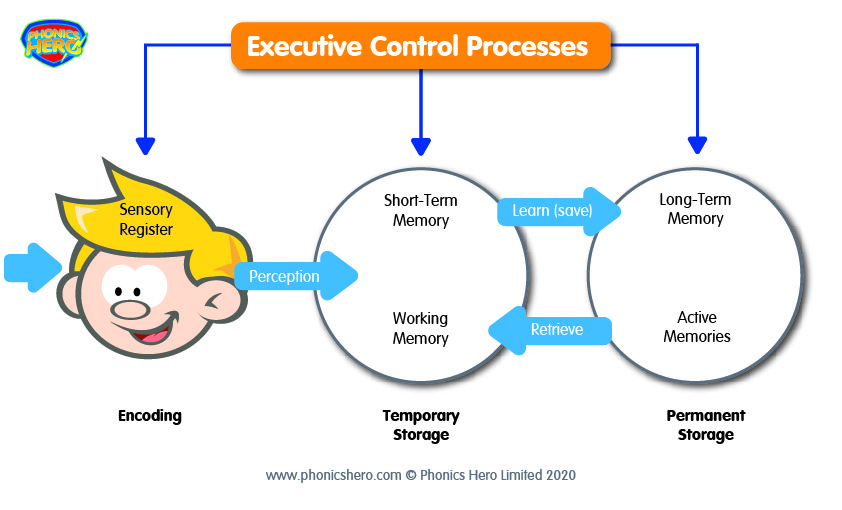
Data processing (adjusted from an paradigm used on this web log from Kiddie Korner).
Short-term retention is housed in the prefrontal cortex of the brain where pocket-sized amounts of data tin be stored for up to 30 seconds.
If that information is rehearsed or repeated oftentimes enough, it will be transferred into long-term memory in the hippocampus, an area deeper in the encephalon.
For case, when you are given a message to pass on but don't have a slice of paper on which to write it at hand, yous probably repeat information technology over and over to yourself until yous notice paper or the person to whom the message must be given.
Working memory
Brusque-term memory is a part of working memory. Repeating a sequence of letters straight afterward y'all have heard it requires only brusque-term memory. Blending the sounds represented by those letters into a give-and-take requires working memory. All novel information is processed by working memory. Working memory works with, and is able to manipulate, that information.
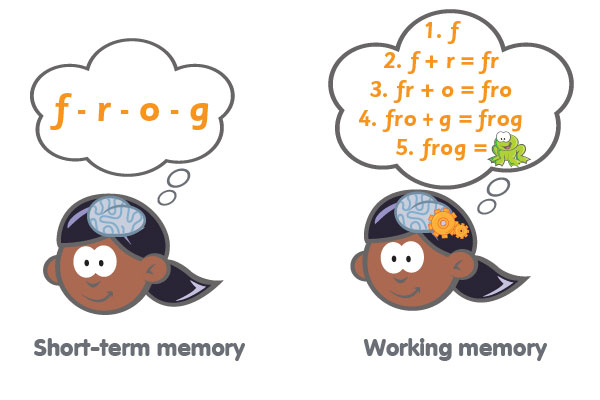 Await at all the effort working memory takes on in a novel task!
Await at all the effort working memory takes on in a novel task! Working retention is an executive office system (a prepare of cognitive processes necessary for the control of behaviour) that controls attending, use of cognitive strategies and retrieval of data from long-term memory. All the components of working retention are in place by historic period 4.
Working retentiveness requires conscious effort and is fragile. Almost all data in working retention is lost after about twenty seconds, unless information technology is constantly rehearsed (recall of our example of remembering a message). If the information is lost, it cannot be retrieved. It must exist inputted again. Students with a learning disability oftentimes have low working memory.
Co-ordinate to Baddeley'southward working retentiveness model, in that location are three main components to working memory. One is a 'phonological loop' which processes speech and other sounds. The other is a 'visuo-spatial sketchpad' that processes text and other visual information.
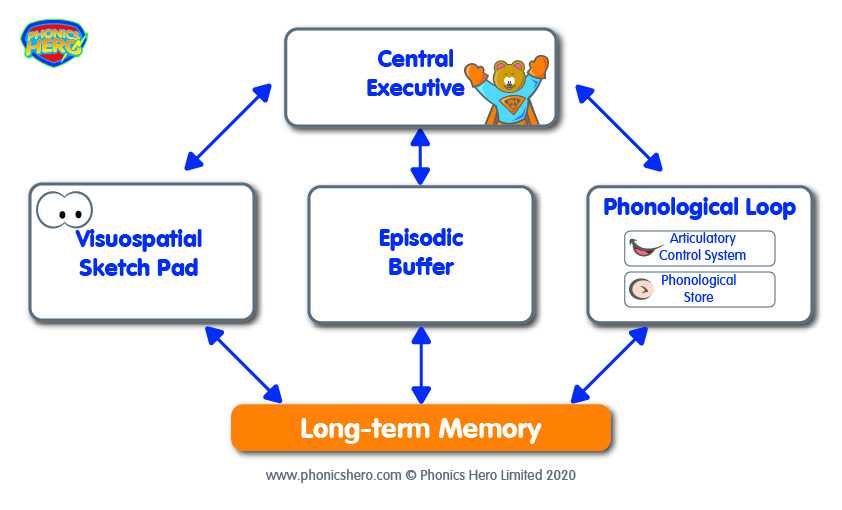
Baddeley's model of working retention (adapted from this prototype).
Working memory is limited, in both capacity and duration. Capacity unremarkably increases steadily from the age of iv until the age of about 14. The average v-6 year sometime can concord and manipulate nigh 2 distinct items of information in working memory. Capacity peaks in immature adulthood, with a 13-15 year-one-time able to concur, on average, 5 items in working retentiveness. Well-nigh adults accept a capacity of 7, plus or minus 2.
Long-term memory
If we want to retain new information permanently, information technology must be transferred from short-term, working retentivity to long-term memory, which is near limitless – very large amounts of information can exist stored in long-term memory permanently. When learning to read, decoding an unfamiliar word requires a meaning amount of witting processing and working retentivity. Reading a familiar word already in the mental dictionary (in long-term retention) does non.
Learned information is stored in cognitive structures called 'schemas'. These provide a arrangement for organising and storing elements of information, according to how they will be used. We construct new schemas in working memory so they tin can exist integrated into existing knowledge in long-term memory. We make schemas of everything, with all the bits of relevant information grouped together.
With sufficient rehearsal and application, these schemas can become automatic, for example, the schema of 'driving a car' or 'reading'. Automated schemas are not consciously processed in working retention so automaticity is an important goal in reading education.

Cerebral Load Theory (CLT) and Reading Instruction
'Cognitive load' is the amount of information processing required to complete a learning task. Look at this 'unproblematic' sentence presented to a 4 year old:

In reading this judgement, on pinnacle of knowing each sound to match the letters, the kid likewise has to:
- Recognise the capital 'D' equally a way to represent the sound /d/.
- Deal with the alphabetic character-sound correspondences in the tricky word 'the' – a voiced /th/ and a schwa sound.
- Work out that two letters can represent a sound, i.e. the 'ck'.
- Know what to do with a full stop.
That's quite a lot of information to deal with!
The load can affect the ability to process new information and to construct knowledge in long-term memory. A high cognitive load puts pressure on working retentivity, making information more difficult to attend to, rehearse and remember. Because working memory is fragile, with a limited chapters and elapsing, transfer of data from short-term to long-term retentiveness is essential for learning to occur. Consequently, instructional design and methods should support working memory, minimise the load placed on it and facilitate the transfer of information to long-term memory.
The 3 types of cognitive load
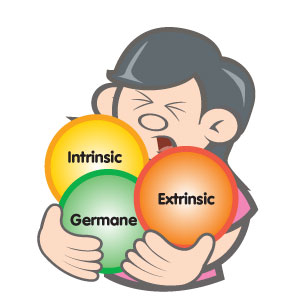
CLT distinguishes betwixt 3 types of cerebral loads on the cognitive system – intrinsic, extrinsic and germane.
Intrinsic load refers to the load imposed by inherent complication of what is to be learned – the 'what I have to be able to exercise' of the chore – too equally the cognition of the learner.
Extrinsic load refers to the load created by the way in which information is presented and the instructional procedure which must be followed – the 'conditions under which I do it', such equally the complexity of instructions, the pace of didactics, time constraints or distractions in the surround.
Germane load refers to the effort or working retention required to process information and create schema. Information technology is linked to the intrinsic load – the more than complex the task, or the more novel the information, the college the germane load.
Chief and secondary knowledge
Primary knowledge is noesis nosotros acquire unconsciously, for example, the ability to listen to, understand and speak the linguistic communication of the dwelling house. It is noesis that nosotros take evolved to larn without education. Our brains are hardwired for listening and speaking. Outside the classroom, almost of what we learn is chief, for example, general problem solving.
Secondary knowledge is acquired merely with conscious effort and good education and thus often learned in the classroom. Our brains are not hardwired for reading and writing (these are human creations), therefore the ability to read and write with phonics requires secondary knowledge – it is rarely 'discovered'; information technology must exist explicitly taught and actively learned. Reading and writing are processes that place a pregnant intrinsic load on the working retentivity of the learner because they require conscious endeavor.
The intrinsic load of the reading process
'Expert' readers process multiple elements in parallel in working retentivity during a reading task. Dr. Hollis Scarborough identifies eight 'strands' or elements in skilled reading and how they come together in her Reading Rope model. In the post-obit video, Dr. Scarborough explains this model of understanding the reading process.
Co-ordinate to educational psychologist John Sweller, information that has been organised and stored in long-term memory has different characteristics than the same data prior to it being stored in curt-term retentiveness. Words are processed by the skilled reader unconsciously as a single element retrieved from long-term memory. Essentially, about words are 'sight words' for an adult reader, decoded and then speedily that they're recognized almost automatically.
Most children begin schoolhouse as 'novice' readers, with little or no give-and-take recognition or literacy cognition, and with background knowledge and other linguistic communication skills dependent largely on the amount of oral linguistic communication experience in the home. Most of what they are learning is unfamiliar, so the intrinsic load of Scarborough's 8-strand reading process is loftier. Remember, at that age, their working retentivity chapters is only 2-3 items.
Children starting school typically rely heavily on visual-spatial working memory due to their lack of phonological awareness. The phonological loop has to be 'switched on' and the children explicitly taught the sound structure of words, so that they tin construct schema for the concepts of word, rhyme, syllable, sound etc. They then take to construct schemas for the squiggles on a page that correspond sounds.
Novices need to utilise thinking skills; experts utilize knowledge."
Sweller et al, 2011, p21.
The novice reader has to process the written discussion in working memory as multiple, interacting elements because the written discussion has non withal been stored as a single chemical element in long-term memory. In decoding unknown words, letter-sound correspondences must exist recalled to convert the letters in a word into sounds. Each sound has to be held in working retentivity while the next is identified. The sounds must all be held in working memory while they are blended to form a word.
Each word has to be held in working memory while the next is sounded out (these are our 'balls in the air'). Those words must and then be combined into phrases and sentences. In his 1999 publication, 'Cognitive inquiry tin inform reading education', Charles Perfetti said that the cognitive load of word decoding is a key barrier to comprehension, creating a 'reading clogging'. When a student can decode fluently, the cognitive load is minimised, making it easier for the educatee to process what has been read, retain vocabulary, link ideas etc. Check out this little girl'south 'reading bottleneck' at 25 seconds where the cognitive load of decoding is then dandy she forgets the meaning of 'sun'!

Some Instructional Design Methods Drawn From CLT
Explicit teaching
In gild to reduce working retentiveness load and facilitate transfer of secondary information to long-term memory, teaching provided past teachers should exist explicit and direct. In explicit teaching the teacher shows the educatee what to practice and how to exercise it, rather than expecting the student to discover or construct knowledge for himself. Have a look at the features that make a corking explicit phonics lesson.
The teacher decides the learning intentions and success criteria for a lesson, makes these transparent to the students, demonstrates them by modelling, evaluates if students empathize what they have been told by checking for understanding, and retells them what they take been told past tying it all together with closure."
Hattie 2009, p. 206.
Instructional sequencing
The cognitive load resulting from a circuitous job can exist reduced past breaking it down into smaller, simpler components. Novices, in particular, benefit from having fabric presented in this style, with plenty of opportunity to practice subsequently each step. The individual elements of information should be taught in sequence, in isolation before presenting all of the elements and their interactions.
Learners should start with piece of work on uncomplicated learning tasks. The more expertise they larn, the more complex the tasks they will be able to work on.
Multisensory instruction
Effective working memory capacity tin be increased by using both visual and auditory working memory rather than either processor lonely, consequently teaching should be multisensory. Movement enhances working memory and then this should be incorporated where possible, e.g. tapping syllables on your lap or moving a counter into a phoneme frame for each phoneme heard.
 A phoneme frame in action.
A phoneme frame in action. Worked examples
CLT emphasises the importance of using worked examples that show learners how to carry out new tasks. A worked instance is substantially a footstep-by-step demonstration that reduces a complex procedure to single actions. This reduces the intrinsic cerebral load.
Guided practice and fading
The 'I do, we practise, you practice' gradual release model of educational activity provides the guided practice that reduces working memory load and facilitate transfer of information to long-term memory.
Spacing
Information technology appears that working memory capacity depletes afterward heavy employ and recovers after rest. Therefore, if learning is spaced with rest periods between learning episodes, it is superior when compared with the same learning time massed without rest periods.
Minimising the dissever-attention consequence
When a learner is presented with two simultaneous instances of the aforementioned blazon of stimulus, the two compete for attention and the extrinsic cognitive load is increased. To avoid the split-attention consequence, teachers should allow students to focus on a single visual or auditory source of information at any given time.
Putting the instructional methods into practice
What can nosotros do as teachers to help students manage cognitive load?
Prior to instruction:
- Pre-examination to determine the student'southward current noesis and skill level. In the Phonics Hero Teacher Account you volition notice many free assessment materials.
- Evaluate the intrinsic and germane loads of reading a particular text and try to reduce the load e.g. by identifying letter-sound correspondences, tricky words and vocabulary that could be unfamiliar to a pupil. The best decodable readers list new correspondences, words containing these and tricky words on the commencement or final pages of the text for you.
- Reduce or remove any possible extraneous load on working memory such as lengthy/complex explanations or instructions, time restrictions, auditory or visual distractions in the classroom.
During education:
- Begin teaching at a point of familiarity, activating prior knowledge. For case, revise previously learned letter-sound correspondences or words with a game. Phonics Hero supplies teachers with complimentary access to their games for apply on the interactive whiteboard with a group of students.
- Pre-teach:
- any letter of the alphabet-sound correspondences in a text that are likely to be unfamiliar. Teach the blending of these to brand the regular words that will be found in the text. Also much novel information can overload working retentiveness. Pre-teaching pre-requisites for a task aids the establishment of schemas that extend working memory.
- Explicitly teach 'catchy' irregular words, drawing attention to any regular alphabetic character-audio correspondences. Phonics Hero teaches how to read and spell 'photographic camera words' in Steps four and 5.
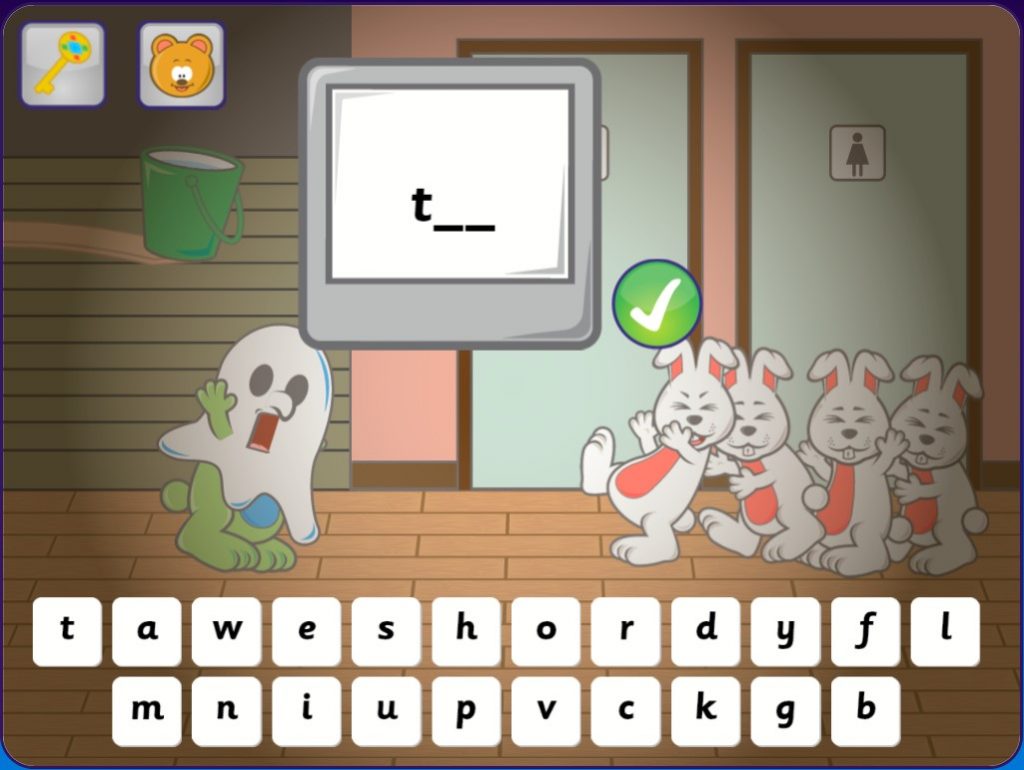
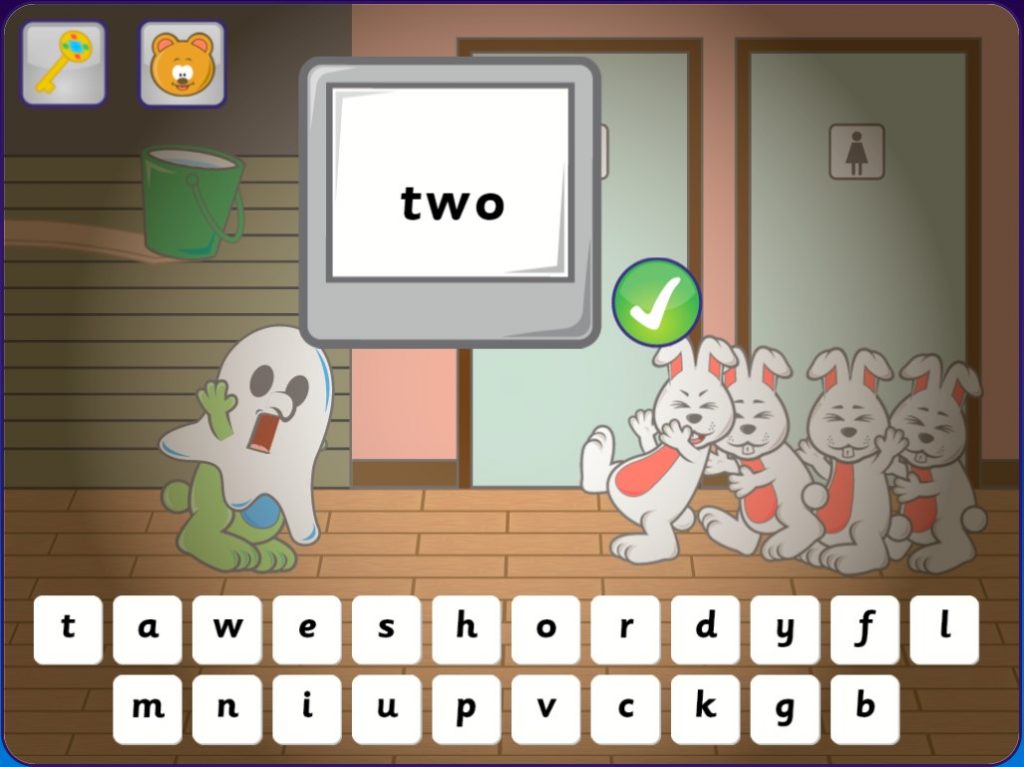
This camera word spelling game emphasises the known alphabetic character-audio correspondence and highlights the irregular bits for exercise.
- Brand certain that students have sufficient background knowledge to access the meaning of the text. It is easier for them to process information if they can link it to existing schemas. Talk about cardinal concepts, new vocabulary, etc.
- Movement systematically from the simple to the complex to support schema formation. The structure of Phonics Hero helps teachers to teach the logic of the alphabetic code. Students learn that one alphabetic character tin represent a sound (e.1000. 'c' can represent /k/) earlier learning that two or more than messages can represent a sound. (e.g. 'ck' can represent /k/). The nigh common representations are taught earlier the less common (e.thousand. 'q' tin represent /k/.
- Use explicit instruction to teach new content and skills. Synthetic phonics programs exercise not ask students to read words they have non been explicitly taught. It is not appropriate to embed phonics pedagogy in text reading or to expect a student to use multiple cues such as context or pictures to decode text.
- Model/demonstrate strategies east.g. right pronunciation of sounds, blending or segmenting a word into syllables
- Use a consistent lesson structure then that the learner can attend to the intrinsic load of the content: review; argument of learning intentions and success criteria; I do, nosotros do, you practise, application; reflection. Download the gratis lesson plan template.
- Make learning multi-sensory to permit apply of both visual-spatial and verbal working memory. Phonics Hero is multi-modal.
- Provide worked examples and problems with partial solutions e.g. audio buttons or dashes to indicate the number of sounds in a discussion or a longer dash for a digraph or trigraph.
- Nowadays oral and visual information together, to facilitate utilize of both visual and verbal working memory. The best electronic books highlight each discussion as information technology is read to the student.
- Cut out non-essential information e.thou. decorative graphics. We need to direct student attention to the information they need. The images on each screen of a Phonics Hero game are kept unproblematic.
- Provide multiple practice opportunities in club to develop automaticity.
- The games of Phonics Hero are an platonic tool for repeated practice as each game is unique, maintaining student enjoyment during repeated use of knowledge and skills.
- Students need the opportunity to practise applying data to new contexts in one case they take learned it. Application is a crucial pace in phonics educational activity that sometimes gets forgotten. The goal of reading is comprehension, so one time the child can decode words, he or she should be applying that skill to decodable readers.
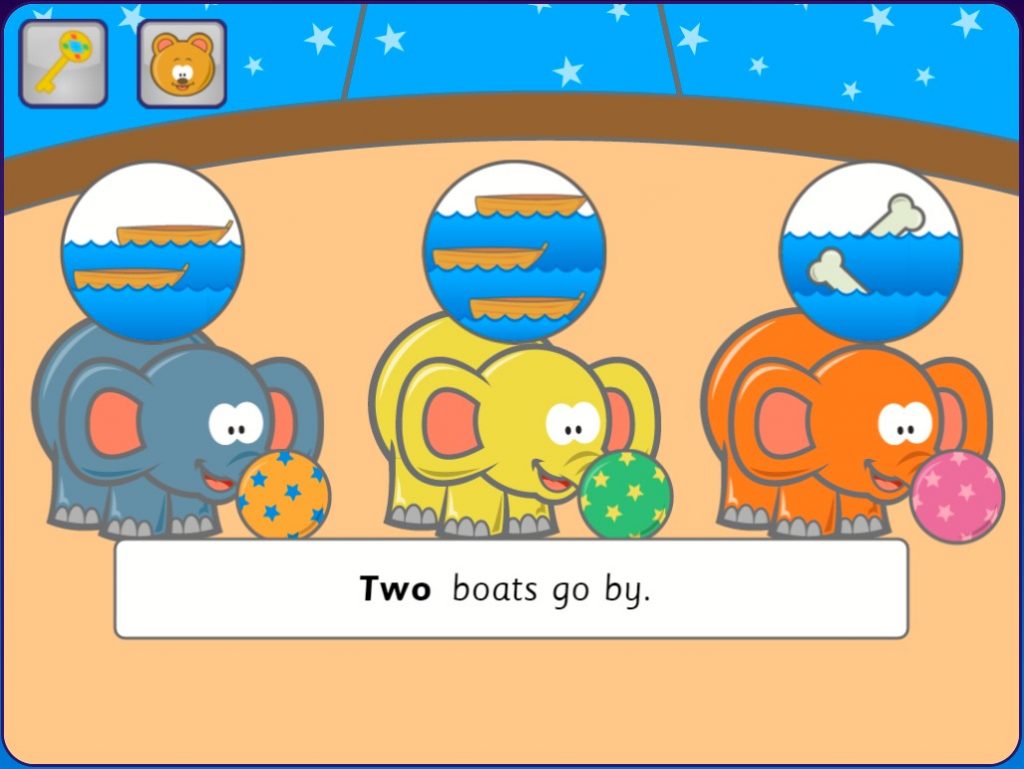 Decodable readers and caption reading, such equally the Sentence Reading games in Footstep 6 of Phonics Hero, reduce cognitive load.
Decodable readers and caption reading, such equally the Sentence Reading games in Footstep 6 of Phonics Hero, reduce cognitive load. - Encourage repeated reading as this helps the student to develop automaticity and fluency, reducing the load on working retentivity and freeing it up for comprehension. For example, take a look at instructor Stephanie Brighton's blog on how she reduced the cognitive load of home readers in the early stages of learning to read.
- Encourage students to visualise what they take read (drawing on paper or in their mind's eye). This encourages them to draw data out of their long-term memory and review what they have learnt/read.
No-Prep Phonics Lessons and Cognitive Load Theory
Phonics Hero's click-and-become Phonics Lessons help you put all of these methods into practice. Our no-prep Phonics Lessons are designed to lessen the cognitive load of phonics learning on students and likewise lessen the cerebral load of preparing a great phonics lesson on teachers! Take a look at this tour of a blending lesson to see it in activeness:
From Ane Teacher to Another…
Many of these instructional recommendations derived from Cognitive Load Theory are but good, common-sense teaching practice. And yet, I all the same see teachers using implicit and whole linguistic communication teaching in reading instruction in classrooms filled with distractions. I encourage you to trial at to the lowest degree i of the recommendations discussed in this web log and monitor the impact on the reading performance of your students. You can practise more in depth reading on working memory on the links below:
Sweller, J., van Merriënboer, J., & Paas, F. (2019). Cognitive compages and instructional design: twenty years afterwards. Educational Psychology Review, 31, 261-292.
Cognitive Load Theory: Research That Teachers Really Need to Understand from the New S Wales' Department for Education
Author: Shirley Houston
With a Masters degree in Special Education, Shirley has been teaching children and training teachers in Commonwealth of australia for over 30 years. Working with children with learning difficulties, Shirley champions the importance of teaching phonics systematically and to mastery in mainstream classrooms. If yous are interested in Shirley's help as a literacy trainer for your school, driblet the team an electronic mail on info@phonicshero.com
Source: https://phonicshero.com/cognitive-load-theory-phonics/
0 Response to "Which Is Higher Cognitive Load, Reading or Pictures"
Postar um comentário